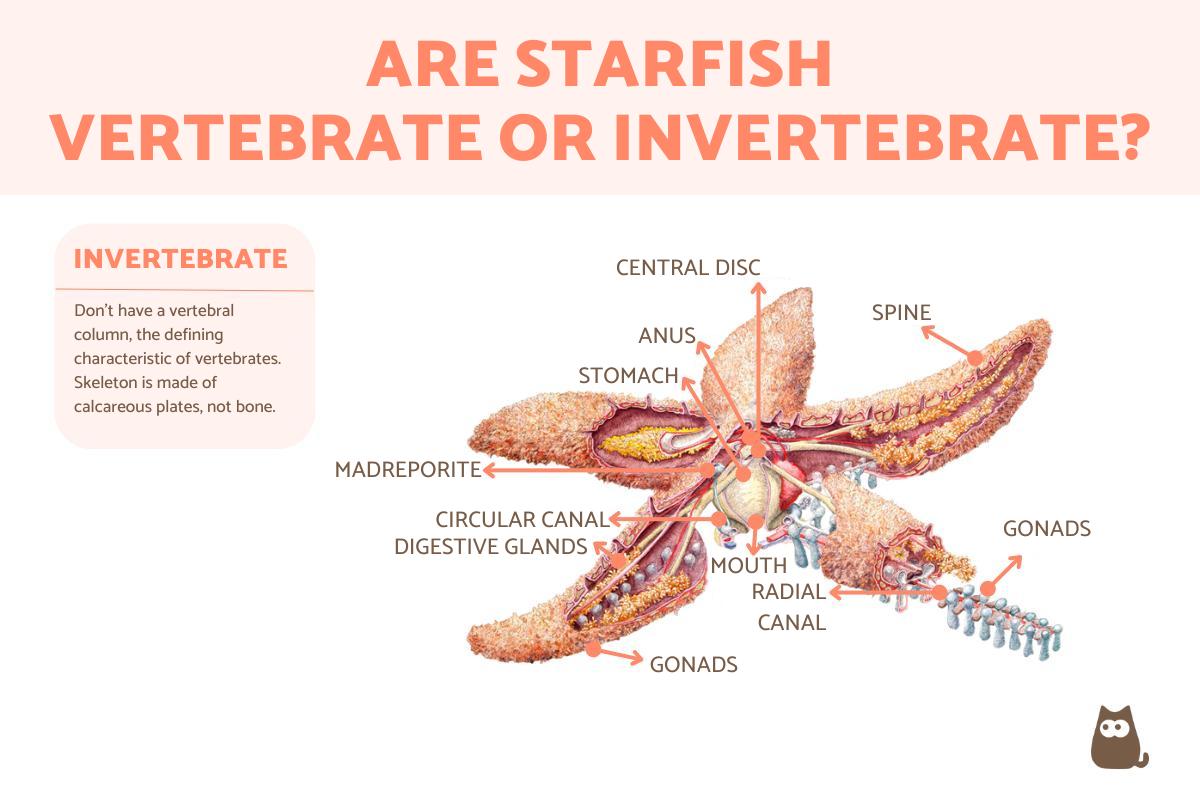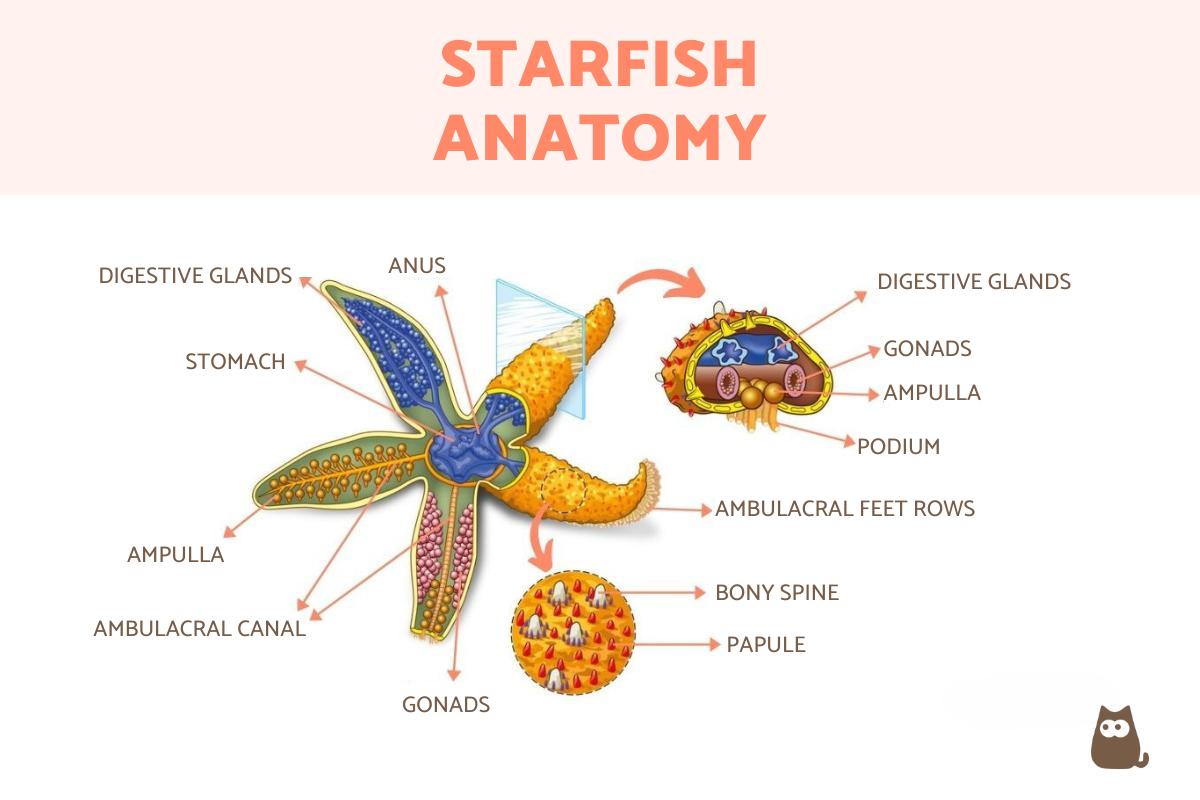Is a Starfish Vertebrate or Invertebrate?


Since they have the word ‘fish’ in their name, it is understandable some of us may wonder if a starfish is a vertebrate or invertebrate. Belonging to the phylum Echinodermata, these majestic animals are among the wonders of the ocean. Their distinct star shape and textured limbs make them a fascinating sight, but it is important to remember they play an essential role in marine ecosystems. Through their diverse forms and unique biological adaptations, starfish offer an intriguing window into the biodiversity and complexity of the underwater world.
In this AnimalWised article we will explore the classification and characteristics of these creatures by asking is a starfish vertebrate or invertebrate?
Is the starfish a vertebrate or invertebrate?
The starfish is classified as an invertebrate. Although it shares similarities with vertebrates in terms of complexity and biological adaptations, it lacks a vertebral column. It is this vertebral column which defines vertebrates, although there are other common features.
Also known as the sea star, the starfish belongs to the phylum Echinodermata. Unlike vertebrates, it has an internal skeleton composed of calcareous plates and a hydrovascular system that it uses for locomotion and other physiological functions. Their name derives from their star-shaped body and they are classified within the class Asteroidea. This includes a wide variety of starfish species which share common characteristics, such as the presence of ray arms that give them their star-shaped appearance.
The anatomy of the starfish is characterized by its radial symmetry. They are generally pentaradial, meaning they have 5 arms, although some species can have up to 20 arms. These arms extend from a central point and contain a complex network of channels of the hydrovascular system. This system allows coordinated movements via the ability to suck in and expel water. Although their nervous system is rudimentary compared to vertebrates, starfish exhibit surprising behaviors, such as the ability to regenerate lost arms.
Starfish diet is varied and they can feed on a wide range of prey, using their reversible stomach to digest food externally. Despite their apparent simplicity compared to vertebrates, starfish play a crucial role in marine ecosystems and offer a fascinating insight into the biological diversity of the animal kingdom.
Learn more about the diet of these fascinating creatures with our article on what do starfish eat?
Why is the starfish an invertebrate?
The starfish is classified as an invertebrate primarily due to the absence of a vertebral column. Invertebrates are animals that lack a vertebral column or segmented internal skeleton. This is in comparison to vertebrates which have a vertebral column that provides structural support and houses the spinal cord. We explain it in more detail with our article on the difference between vertebrate and invertebrate animals.
In the case of the starfish, its internal skeleton is made up of calcareous plates. These are not the same as bones or cartilage that make up the vertebral column in vertebrates. Although it shares certain characteristics with vertebrates, such as the presence of a nervous system and a more complex structure compared to many other invertebrates, the lack of a vertebral column clearly places the starfish in the invertebrate category.
Additionally, as we mentioned, starfish have a hydrovascular system. This is a network of fluid-filled channels that they use for locomotion, prey capture and other physiological functions. These distinctive biological adaptations reinforce their classification as invertebrates, contributing to the fascinating diversity of life forms in the animal kingdom.

Starfish Classification
The taxonomic classification of starfish is within the phylum Echinodermata and the class Asteroidea. Below we provide you with a more detailed classification:
- Kingdom: Animalia (animals)
- Phylum: Echinodermata (echinoderms)
- Class: Asteroidea (starfish)
Additionally, there are different orders within the Asteroidea class. They include:
- Brisingida: characterized by starfish with a small, inflexible disc with thin arms used for suspension feeding. They usually live in deep waters and there are more than 110 species within this order.
- Forcipulatida: includes species with distinctive pedicellariae consisting of a short stems with three skeletal ossicles. The more than 260 species of this order have robust bodies and are found in temperate regions, as well as cold and abyssal waters.
- Paxillosida: this order is characterized by starfish that lack an anus and do not have suction cups on their tube feet. They usually live in areas with soft bottoms, such as sand or mud. It consists of around 372 species.
- Notomyotida: the 75 species that make up this group are starfish that live in deep waters and have flexible arms. Some species of this order have longitudinal muscular bands on the inner dorso-lateral surface of the arms.
- Spinulosida: most species (about 120) in this order lack pedicellariae and have a delicate skeletal arrangement with small marginal plates on the disc and arms. They usually exhibit numerous groups of low spines on the aboral surface.
- Valvatida: this is the most diverse order, with more than 700 species. It is mostly composed of starfish with five arms and tube feet. They have notable marginal plates on the disc and arms. Their main pedicellariae resemble pincers.
- Velatida: this order includes primarily cold, deep-water starfish, often with a global distribution. Composed of more than 130 species, they usually have a star or pentagonal shape, with five to fifteen arms. Most have poorly developed skeletons.
Please note that taxonomic classification of starfish and any other invertebrate may change with new research and discoveries. It is advisable to always consult up-to-date sources for accurate and complete information on starfish orders.
Now that you know that starfish are invertebrates, keep learning and discover more about how starfish are born and the stages of the starfish life cycle.
If you want to read similar articles to Is a Starfish Vertebrate or Invertebrate?, we recommend you visit our Facts about the animal kingdom category.
- Blake, D. B. (1990). Adaptive zones of the class Asteroidea (Echinodermata). Bulletin of marine science, 46(3), 701-718.
- Gale, A. S. (1987). Phylogeny and classification of the Asteroidea (Echinodermata). Zoological Journal of the Linnean Society, 89(2), 107-132.
- Gale, K.S., Hamel, J.F., & Mercier, A. (2013). Trophic ecology of deep-sea Asteroidea (Echinodermata) from eastern Canada. Deep Sea Research Part I: Oceanographic Research Papers, 80, 25-36.
- Howell, K. L., Pond, D. W., Billett, D. S., & Tyler, P. A. (2003). Feeding ecology of deep-sea seastars (Echinodermata: Asteroidea): a fatty-acid biomarker approach. Marine Ecology Progress Series, 255, 193-206.
- Mah, C. L., & Blake, D. B. (2012). Global diversity and phylogeny of the Asteroidea (Echinodermata). PloS one, 7(4), e35644.






